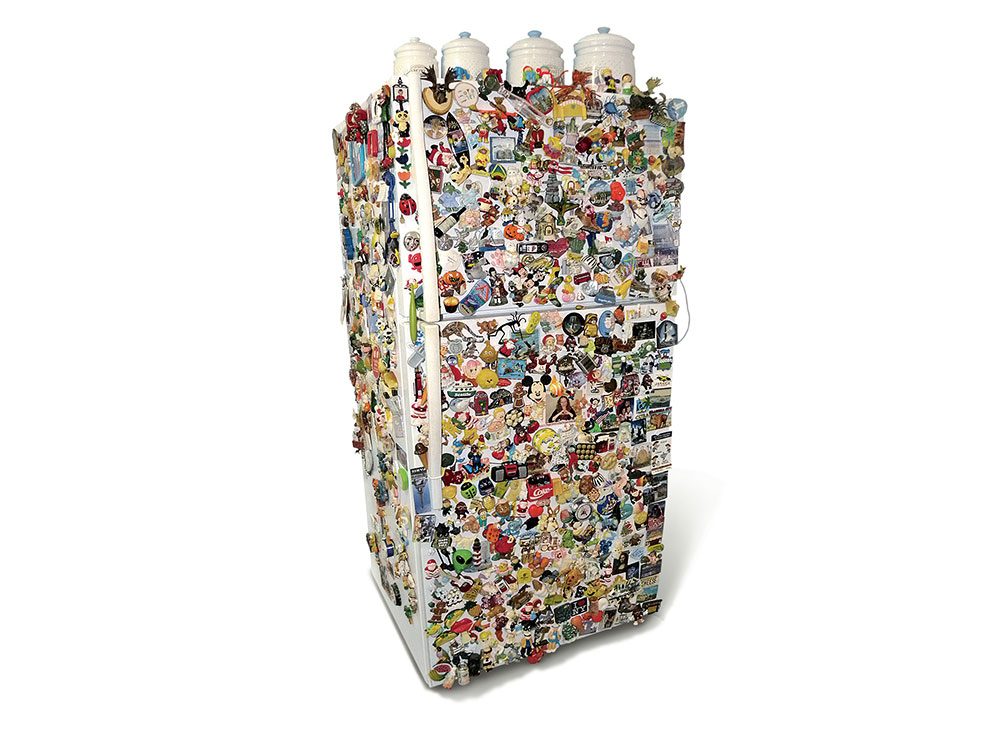
In 1972, Richard Nixon was president, Eugene Cernan became the last man to walk on the moon, and The Godfather won the Academy Award for Best Picture. But perhaps most notably, 1972 was the longest year in the history of recorded time, outlasting other years by a whopping two seconds.
So how’d that happen? To start, 1972 was a leap year, meaning it already had an extra 24 hours than most years. But on top of that, it also included two leap seconds: one added to the clock on June 30 and another added before 7 p.m. EST on December 31. Timekeepers around the world honoured the leap seconds, and took action to adjust their clocks as part of an international agreement, as reported by the New York Times.
The reason for leap seconds is similar to the reason for leap years: they make it possible to align astronomical time, which is determined by Earth’s irregular rotation, with Coordinated Universal Time (UTC). Since the system was implemented in 1972, 27 leap seconds have been applied, the most recent on Dec. 31, 2016. (We’re debunking common myths about daylight saving time.)
For an example of how leap seconds are inserted, here’s what time looked like that New Year’s Eve:
2016 December 31, 23h 59m 59s
2016 December 31, 23h 59m 60s
2017 January 1, 0h 0m 0s
…instead of:
2016 December 31, 23h 59m 59s
2017 January 1, 0h 0m 0s
Currently, each leap second is usually announced about six months in advance by the International Earth Rotation and Reference Systems Service, which means you’ll have ample time to decide how to spend your extra second.
For more can’t-miss trivia, read up on these 51 common “facts” that are actually false.

Steve Jobs’ Career Pro Tip
Do you have what it takes to land a job at one of the best companies to work for? Sure, you can perfect your resume, dress to impress, and nail the trickiest interview questions. But odds are, you’re probably forgetting one rather unusual quality—and for Steve Jobs, it matters much, much more than a polished CV. (Top recruiters reveal the best way to explain a resume gap.)
Back in the day, Jobs hired a few professional managers for his growing company. But he quickly learned that “most of them were bozos,” he said in a video. “They knew how to manage, but they didn’t know how to do anything.”
So, from there on out, Jobs began to value a different trait in job candidates. “We wanted people that were insanely great at what they did, but were not necessarily those seasoned professionals,” he said. “But who had at the tips of their fingers and in their passion the latest understanding of where technology was and what they could do with that technology.”
In other words, forget job experience; Jobs wanted passionate people on his team, instead. Why, you ask? Not only can enthusiastic employees manage themselves, but they also understand the company’s mission—and strive for that common goal with earnest. (These five jobs will be extinct in the next decade.)
To find employees with this type of passion, the Apple team interviewed each job candidate by presenting a Macintosh prototype and noting his or her reaction. “We wanted their eyes to light up and to get really excited,” Andy Hertzfeld, one of Apple’s first software engineers, said. “Then we knew they were one of us.”
Having this skill can help you succeed in any type of workplace—whether your dream job is at Apple or not. Making the right impression doesn’t stop when you land the job, though.
Discover how to stand up to bullies at the workplace and at home.
[Source: Inc.]

Let’s face it—writing checks these days is kind of an old-fashioned thing that not that many people do anymore. Most of the time, it’s just inconvenient to write a check when you could use your debit card, a mobile app, or any other form of online bill paying. Well, Queen Elizabeth II is right there with you. But, the reason she doesn’t write checks isn’t because she’s transferring money through mobile apps like everyone else these days—it’s for a far different reason! (You won’t believe how many places around the world are named after her, either.)
Queen Elizabeth II doesn’t write checks out because people would never cash them. Why? People preferred to keep them as mementos instead since they had her signature on them—a likely way to get around the fact that no one in the royal family is allowed to give autographs. While it might be a nice conversation starter or something to brag about at a commoner’s dinner party, it’s a huge pain for the royals’ banking records.
The cashing checks issue was a major problem for both Queen Elizabeth II and her mother, Queen Elizabeth The Queen Mother. After writing out so many checks, the Queen Mother was said to have an overdraft of £2 million after she passed away, which her daughter settled.
So, instead of having to deal with another headache from the bank, the Queen just doesn’t write checks anymore. She also doesn’t use Venmo though, so don’t get your hopes up that you might be able to sell a screenshot of the transaction online for a couple grand.
Next, check out how much each person in the royal family is actually worth!
[Source: dailybeast.com]

Pro Tip: Never Add Oil to Your Pasta Water
Whether you’re craving a quick-and-easy snack or gourmet meal, you can’t go wrong with pasta. It doesn’t take an all-star chef to toss some noodles and sauce together, after all. But while science recommends salting the pasta water before bringing it to a boil, you might want to think twice before adding oil to your pot, as well. Experts say this one simple mistake could be mucking up your entire meal.
Most veteran pasta makers add oil to their pasta water to prevent the noodles from sticking together, or to keep the water from boiling over. But their best intentions could backfire, Curiosity reports. (By the way, here are some other ways you’re cooking pasta wrong.)
Here’s why: Thanks to the basic rules of science, oil doesn’t mix with the water. As a result, only a tiny bit of the oil, if any at all, will even make it onto the pasta as the water boils. It’s more likely that the oil can attach to the noodles after you drain them, instead, preventing sauce from sticking to the pasta. (Find out the seven cooking mistakes everyone makes.)
Fortunately, there’s an easy fix to this cooking conundrum. Experts recommend using a large pot and lots of water to give the pasta plenty of room to move around as it cooks. You can also stir the pasta as soon as you place it in the pot—and periodically for the rest of the cooking time—to prevent the noodles from sticking together. And to avoid sticky pasta after it is cooked, try adding the sauce while both are still hot, or using a bit of water to loosen the noodles before serving. Who knew such a simple dish could be so complex?
Here are six healthy pasta alternatives that are sure to fill you up and satisfy your craving!

Have you ever written a sentence like this? “On my ice cream sundae, I always like to add extra toppings, i.e., crushed nuts.” We know, it’s hard to think about using proper grammar when you’ve got ice cream on the mind. But, news flash—this sentence is wrong, and no one is getting any ice cream (sigh).
One of the biggest errors people make in their writing is misusing the Latin abbreviations “i.e.” and “e.g.” E.g. stands for exempli gratia and means “for example.” I.e. is the abbreviation for id est, which translates to “that is.” (These are other grammar mistakes you’ve most likely been making.)
That being said, “i.e.” is not used for listing examples—it’s used to clarify a statement. An easy way to remember the correct way to use “i.e” is thinking of it as “in essence.” It’s used incorrectly in the sentence above because by using “i.e.” you are declaring that crushed nuts are the only sundae topping that exists. That’s false (thank god). The correct sentence would be, “On my ice cream sundae I always like to add extra toppings, e.g., crushed nuts.” (Here’s the reason why the contraction for will not isn’t “willn’t.”)
The correct way to use “i.e.” is to explain what you just said but in a different way. For example, “My favorite type of ice cream sundae is a banana split, i.e., three scoops of ice cream served in between a cut open banana.”
You should use “e.g.” when the list that follows is infinite. We used “e.g.” in the first example sentence because there are infinite amounts of ice cream toppings. Another way to write the sentence could be, “On my ice cream sundae I always like to add extra toppings, e.g., crushed nuts, sprinkles, cherries, and chocolate chips.” (Check out these weird facts about punctuation marks you see everywhere.)
“I.e.” and “e.g.” can be used with either commas or parenthesis. Therefore, you could also write the first sentence like this: “On my ice cream sundae I always like to add extra toppings (e.g. crushed nuts).”
Wow! That was a lot of information packed into six short paragraphs. If you want the CliffsNotes version just remember…
E.g. = for example = “egg xamples” = infinite list of possibilities
I.e. = that is = “in essence” = finite list
That’s enough grammar for one day! Check out 20 Jokes Every Grammar Nerd Will Appreciate.
[Source: Grammarly]

Serotonin Syndrome Symptoms
Serotonin syndrome is a condition that occurs when there’s too much of the neurotransmitter serotonin in the body. Taking medications that affect serotonin levels—such as some migraine medications or antidepressants called selective serotonin reuptake inhibitors (SSRIs)—is usually the trigger, especially if those medications are mixed with illicit drugs, supplements such as St. John’s Wort, cold medicine containing dextromethorphan, and some anti-nausea medication. Pay special attention if you’re taking migraine medications known as triptans (such as Imitrex or Zomig) together with SSRIs (such as Celexa, Zoloft, or Prozac) or serotonin/norepinephrine reuptake inhibitors, SNRIs (such as Cymbalta or Effexor). Serotonin syndrome symptoms tend to present within 24 hours of a change in dosage or medication regimen. (Here’s your guide to understanding ocular migraines.)
With treatment, serotonin syndrome symptoms typically disappear quickly, but left untreated it can be deadly. “Serotonin is responsible for regulating the nervous system, including body temperature, muscle tone, and behaviour, gut motility, and constriction of the blood vessels in the body. When levels are high, the different body systems regulated by serotonin get over-stimulated,” says Jeahan Colletti, MD, an emergency medicine physician at Mayo Clinic in Rochester, Minnesota.
It’s possible to prevent serotonin syndrome, mainly by managing your prescriptions. First, it’s important for you to be educated about the medications being prescribed—that way you’re aware of any side effects or potential drug interactions you may experience. Your doctor should also practice caution, especially if the medications are new to you. “It is extremely important that providers are familiar with medications that increase serotonin neurotransmission, and are cautious when prescribing these medications. They should be introduced very slowly and discontinued if the patient experiences any serotonin syndrome symptoms,” says Dr. Colletti.
Changes to mental state
Anxiety, confusion, irritability, and delirium are telltale symptoms of serotonin syndrome, since the chemical plays a role in mood regulation.
Diarrhea or nausea
Serotonin is primarily found in your digestive tract and helps regulate bowel movements and digestion. A sharp increase in the chemical may cause nausea, vomiting, or diarrhea.
Muscle rigidity
Your muscles feel tense, stiff, or painful for no obvious reason. A doctor may prescribe a sedative to ease discomfort until serotonin levels return to normal.
Dry mouth
This can be a side effect of some antidepressants, but if it’s new to you, it could signal an overproduction of serotonin, especially is you’re on multiple medications or have used stimulating drugs, like cocaine, amphetamines, and LSD.
Tremors or reflex changes
Your limbs feel shaky or spasm, reflexes seem overactive or exaggerated, or you are suddenly uncoordinated.
Sweating or fever
Excessive sweating when you’re not exerting yourself, or a fever without any other symptoms of a cold or the flu.
Hypothermia and shock
You get progressively sicker and potentially develop hypothermia or go into shock.

We’ll begin by stating the obvious: Thanks to social media, your private life is now ripe for the picking. That especially goes for Facebook. In fact, it’s now easier than ever for hackers and scammers to get their hands on your personal information through the site—especially if you share too much on Facebook. And although you may filter yourself on social media, odds are you’re still vulnerable to online predators, thanks to one little-known feature. (Here’s why you should never argue with anyone on Facebook.)
Those who keep their “who can look me up by phone” setting on Facebook available to the public also allow their phone number to be public, as well. Put another way, if your privacy settings allow anyone to look you up using your phone number, then anyone can see your phone number, too. The setting itself defaults to “public” view, so it could even be turned on without your knowledge. (Science reveals why Facebook is so addictive.)
Sounds a bit worrisome, right? It essentially means that anyone who wants to contact you—including solicitors and scammers—can do so, simply by taking a look at your Facebook profile. (Discover how social media can damage your relationships.)
If you want to save your phone number from prying eyes but still want it on your profile, here’s what to do. Select the down arrow at the top right side of your profile page and choose the Settings option from the drop-down menu. Click “General” from the side menu, then “Contact” to see if you have a number listed. Now, you can limit who can search for you by selecting “Privacy” from the menu on the left side of the page. And you can also change the default setting for “Who can look you up by phone number” to “Friends” or “Friends of friends.” Done!
It’s important to watch what you post. Screen for safety first by avoiding these posting pitfalls.

Take a peek at this Canadian’s magnet collection
My mother, Elizabeth (Maw) Whynot of Liverpool, N.S., met and married my father, Robert (Paw) Peacock, during the Second World War. Paw was assigned to the naval frigates that escorted convoys across the North Atlantic. His ship was often docked in Liverpool harbour. After the war, they moved back to Paw’s hometown of Sudbury. In 1952, they moved into a home in Lively, Ont., which they referred to as their mansion.
Maw and Paw raised six children, who gave them 12 grandchildren, who in turn produced 21 great-grandchildren.
Maw and Paw were themselves raised in a simpler time. Maw’s large family, like most back then, stayed close to the original homestead to raise their families. Maw, however, moved to Sudbury by train—experiencing her first Sudbury winter was quite a shock. Hearing the stories of that trip while growing up, along with tales of the hardships endured during their early years, inspired all of us to take chances and become travellers.
It started with short trips to places such as Niagara Falls, Thunder Bay and Toronto. On trip after trip, a simple fridge magnet was always purchased and brought home to Maw as a souvenir. As our trips ranged further and further from home, magnets continued to be added to Maw’s fridge.
Soon the grandchildren travelled even further afield and they, too, continued to add magnets to the fridge. Maw’s collection of magnets grew along with her collection of stories.
It was a thrill to add to her collection and have your magnet placed alongside the others, as you told Maw your travel story. It didn’t take long to fill the entire front of the fridge and then the exposed side.
Maw’s magnets have come from the United States, Mexico, Caribbean Islands, Europe, Japan, China and Australia. Each magnet captures the colours, tastes and culture of the place visited. (Check out the best cities in the world for every type of traveller.)
Sadly, Paw passed away in 2015. Maw is now 92 and still living in her own home. As each family member ventures further from home, a “Maw prayer” always precedes him or her.
Over the years, the grandchildren and great-grandchildren have enjoyed playing with the magnets on the fridge, constantly rearranging them. Every spring, the magnets come off the fridge, are lovingly washed in hot soapy water and the stories are remembered. Maw has truly travelled the world through her family.
Check out this Canadian’s impressive model truck collection!
Explore more of Our Canada!

Veteran Profile: Alexander Kovar
Alexander was born in Czechoslovakia in 1926, and immigrated to Canada in 1929. At 16, he enlisted in the Canadian Army, training in Dundurn, Sask., before being sent overseas with the 8th Canadian Reconnaissance Regiment of the 14th Canadian Hussars. He landed in Normandy only weeks after D-Day, and saw front-line action from France through to Germany.
“I walked in to the (recruiting) office and an old fella said, ‘Sonny, you better go back home, and grow a bit of a moustache if you can. Maybe try shaving a little bit every day.’ I did that, came back in a few weeks and he said, ‘Well, I’ll sign you up but you’ll probably be back here in a week.’ I was only 16.”
Alex was discharged in January 1946 and now lives in North Battleford, Sask.
For more profiles by Veterans Voices of Canada, click here.

Why is the Coca-Cola Logo Red?
Coca-Cola and the colour red go together like peanut butter and jelly, milk and cookies, or tacos and Tuesdays. After all, we would recognize that iconic red label anywhere. But why did the company choose this shade for its logo in the first place?
Some claim that the red colour came from one of the company’s first advertisements, which featured Santa wearing his famous red-and-white suit and holding a Coke bottle. But according to the Coca-Cola Company, its famous logo dates back to the very beginning of the brand itself. (You might be surprised by the quirky, secret messages hidden in famous company logos, too.)
Over 130 years ago, the drink was sold in barrels at American drug stores and pharmacies. Alcohol was distributed in the same way. But while alcohol was taxed at the time, soft drinks were not. So, the Coca-Cola Company began painting its barrels red in order to help customs and tax officials distinguish them from barrels of booze. (You won’t believe what this company is doing with old Ford Mustangs.)
The shade stuck—and the rest is history. Now, “You see a red disc icon on a storefront, and you know that you’ll be able to get delicious, ice-cold Coca-Cola there,” Ted Ryan, a Coca-Cola archivist, said. “It became a promise in a way.”
You won’t find this beverage’s famous hue in any Pantone colour registries, though; it is actually a combination of three different shades of red. The logo’s typography, on the other hand, is an official font. Called “Spencerian,” it has been associated with the brand since the 1900s. That said, the label hasn’t always looked the same as it does today.
Check out 17 Famous Company Names You’re Actually Pronouncing All Wrong!
[Sources: Business Insider, The Sun]